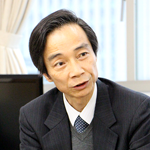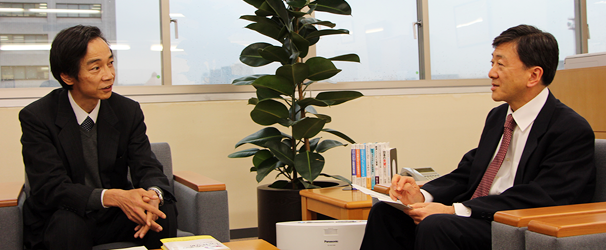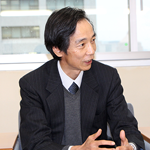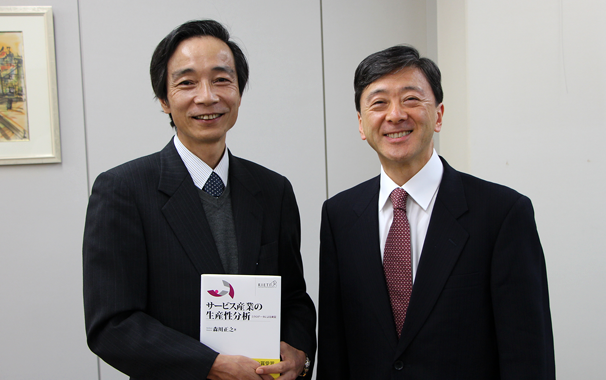Productivity in Service Industries: Empirical analyses using microdata, written by RIETI Vice President and Vice Chairman Masayuki Morikawa, received the 57th Nikkei Prize for Excellent Books in Economic Science. In this interview, RIETI Chairman Atsushi Nakajima speaks with Morikawa about his research findings and related issues.
NAKAJIMA:
Congratulations on your winning of the 57th Nikkei Prize for Excellent Books in Economic Science.
MORIKAWA:
Thanks very much.
NAKAJIMA:
Today I'd like to ask you about the background of your book and the issues on which you were focused when performing your analyses. I'd also like to hear about your ideas for future research in this area.
First, from what perspective did you undertake this research?
 MORIKAWA:
MORIKAWA:
I think motivation is the most important factor in any research effort. In this sense, I was very clearly motivated in this particular area. In my previous positions at the Ministry of Economy, Trade and Industry (METI), I had considerable experience looking at the macroeconomy and industrial structure as a whole. For example, I spent two years working as Deputy Director and Director of METI's Industrial Structure Policy Division. Formerly called the Ministry of International Trade and Industry (MITI), METI has always had a strong focus on manufacturing, but my own feeling consistently has been that invigorating the service industries is of greater significance for the Japanese economy as a whole.
Another thing that triggered me was my involvement with the startup of the Service Productivity & Innovation for Growth (SPRING) platform led by Chairman Jiro Ushio. I assisted him for about a year at that time, and I became keenly aware that economic research on the service industries had been extremely scant, both in Japan and abroad. So then I thought that I should try to do something myself. Since I was a RIETI senior fellow on a part time basis at the time, I published some research papers on this issue. That's how I got motivated to research this area.
Data on the service industries and methods of analyzing the data
 NAKAJIMA:
NAKAJIMA:
The word "service" has a broad range of meanings. What's the best perspective to have? How can we measure service productivity--what units can be used to quantify the service that a customer consumes? How can we extract and analyze the data on the service industries?
MORIKAWA:
The tertiary sector accounts for over 70% of the economy; and even if we focus on only the narrowly defined service industries, these still account for over 20% of value-added, which is more than what the manufacturing sector contributes. At the aggregate level, analysis will be conducted at the level of the tertiary sector or the narrowly defined service industries. In studying service productivity in particular, it is crucially important to look at the microdata at the establishment level. Compared to the manufacturing sector, however, the data for the service sector are much more limited. My two main data sources were the Basic Survey of Japanese Business Structure and Activities and the Survey of Selected Service Industries. For some parts of the research, I used several other data sources as well, including the Basic Survey on Wage Structure.
The Basic Survey of Japanese Business Structure and Activities covers wholesale and retail, and its coverage has expanded significantly to include data on entertainment services and other business-to-business services including information service industry--data that fall within the narrow definition of the service industries. So I used this survey for company-level data. Also, its advantage is that it can be easily used to create panel data. However, the survey covers mainly services under the jurisdiction of METI, and it doesn't provide data on some of the relatively important areas such as medical services, welfare services, and educational services--and this is certainly a significant limitation.
I used the Survey of Selected Service Industries to analyze productivity at the establishment level. This survey also covers businesses that METI oversees--movie theaters, bowling alleys, golf driving ranges, fitness clubs, and so on. I used this survey extensively as well as it allowed me to conduct analysis that I could not do with the Basic Survey of Japanese Business Structure and Activities.
NAKAJIMA:
So the available data are quite limited, and there are also disparities in the data available across different businesses. I assume it was quite difficult to produce quality research results from objective and academic standpoints. How did you manage to explore the data specifically?
MORIKAWA:
In analyzing productivity, measuring total factor productivity (TFP) as opposed to labor productivity is desirable. When I began doing this work, researchers in Professor Kyoji Fukao's research group had already been using the Basic Survey of Japanese Business Structure and Activities to measure TFP at the company level--so a methodology was already in place.
On the other hand, almost nobody had used the Survey of Selected Service Industries data, so I developed my original methods for analyzing that data. I was at a loss at first, since the Survey of Selected Service Industries did not include the detailed financial data that you could find in the Basic Survey of Japanese Business Structure and Activities, but I made some innovations that led to a workable approach.
In measuring TFP, outputs and labor inputs/capital inputs are necessary. Sales revenue data show outputs. But for inputs, while there are data on the number of workers by sector to show labor inputs, no data on capital stock were available. Then I started to think about what to do and noticed that there were good proxies for capital stock: for example, the number of holes for golf courses, the number of seats for movie theaters, and the number of lanes for bowling alleys. Although capital stock in value terms has a variety of technical issues including adjusting prices into real terms and taking depreciation into account, there is no room for such question when using physical capital stock--they are excellent data. Of course, looking at its small details, it can be argued that a hole on an inexpensive golf course does not match the quality of a hole on an exclusive course, but I will leave it for now.
As physical data for output are also available such as the number of games or visitors, I measured TFP physically by combining input and output data.
I think the research is very unique in the sense that I analyzed the productivity of service industries using only physical data. Recently, we have started to see some research conducted overseas that look at the differences between physical output-based TFP (TFPQ) and revenue-based TFP (TFPR), but there is no doubt that it was a very pioneering approach at least.
NAKAJIMA:
So, it seems that you found it very challenging to find the necessary figures to conduct your research. One academic contribution that your research has made is that it showed that services are produced on the basis of goods--although service industries do not sell goods.
MORIKAWA:
In other words, tangible capital is necessary in service industries as well. In retail, stores are capital. In terms of producing output combining capital and labor, manufacturing and service sectors are essentially the same. The only distinct difference is that service sector does not have inventories. In typical service industries, production and consumption occur simultaneously. Analyzing by focusing on the simultaneity is a novel approach and perhaps has made some academic contribution.
The simultaneity referred to here has two aspects, namely, spatial or locational simultaneity and temporal simultaneity. I have written several papers on this topic. There has been hardly any such research conducted in the past.

Policies toward improving service productivity
NAKAJIMA:
Let me digress a bit. In order to improve productivity in manufacturing, when a large forthcoming jump in sales is expected, production will be increased beforehand to maintain inventories. However, I conjecture that it would be rather difficult to improve productivity in the service sector where inventories cannot be kept.
MORIKAWA:
As demand fluctuates, smoothing the change in demand is necessary to improve productivity. Prices will be adjusted according to different time periods of a day or different days of a week to smooth demand temporarily. The classic example is the airline industry where IT is used to raise the operating rate, and tickets are discounted during seasons or periods when few passengers can be expected.
On the other hand, it is much harder to overcome issues related to locational simultaneity as urban structures or geographical distributions of population are the key factors. It is also closely related to political aspects such as national and urban planning and regional revitalization which have been discussed recently.
NAKAJIMA:
In the service industries, each company can smooth demand fluctuation with its own efforts in facing temporal simultaneity. In terms of locational simultaneity, however, emphasis is more on policies. Is that what you imply?
MORIKAWA:
As I said, one of the measures to overcome temporal simultaneity of production and consumption is to smooth demand, but another way is to adjust inputs in accordance with the fluctuating demand. For example, a barbershop cannot change its facilities temporarily. In the short-run, only labor input can be changed. As the share of labor input is larger in the service sector compared to manufacturing, the key will be how flexible labor input can be adjusted. Of course, efforts by each company are necessary, however, institutions related to non-regular employment (temporary agency worker, part timer, etc.) and working hours have significant influence in the sense that they determine the boundary of what companies can do.
Regional revitalization and productivity of service industries
 NAKAJIMA:
NAKAJIMA:
You mentioned that getting involved in establishing SPRING also motivated you in your research. Currently, regional revitalization has become an important policy issue, and as manufacturing is not the only sector located in these areas, the service sector should also play an important role in revitalizing the local economy. How should your research or your awareness of these issues be included in the measures for revitalizing the rural areas? What kind of perspectives should we have in looking at them?
MORIKAWA:
Regional revitalization is being discussed widely and the Industrial Competitiveness Council, for example, is also discussing how to improve the productivity of service industries. It is gradually becoming known that the productivity of service industries is crucial to implement the Abenomics' third arrow. While regional revitalization is not only about the service industries, they are significantly related. The implications of my analyses are very simple: with the decreasing population, it is important for Japan to take a "selection and concentration" approach and build cities as compactly as possible.
When the Organisation for Economic Co-operation and Development (OECD) compiled a report on compact cities in 2012, it quoted a page from a paper of mine that became the basis for a chapter in my book. It seems that the OECD, too, was aware that productivity in the service industries is an important aspect in considering a compact city. In 2014, Japan passed a law (Act on Special Measures concerning Urban Reconstruction) (Act No. 22 of 2002 as amended on August 1, 2014) that promotes the concept of a compact city. I think I can discern a gradual shift in that direction. However, in discussing regional revitalization, people seem to support the idea of reversing the flow of population into Tokyo to invigorate all of the other regions. Although the report published by the Japan Policy Council, which created a momentum for discussion on regional revitalization, calls for "selection and concentration" and regional hub cities as the core, there is a risk of things not going in that direction. Amid the population shrinking, how to maintain a certain level of agglomeration is the important implication drawn from the analyses on service industries.
NAKAJIMA:
In recent years, there has been no significant increase in employment and output in Japanese manufacturing. Meanwhile, with the aging population, an increasing number of people are employed in health care and welfare services, unfortunately, however, if we look at the average wages, they are relatively higher in manufacturing and lower in health care and welfare services. As the industry structure changes and the shift in labor force continues, the overall level of wages in Japan may decline, rather than increase. Would you suggest that the concept of compact cities also will serve to enhance the productivity of health care and welfare services?
MORIKAWA:
Yes, absolutely. Although the urban wage premium can be observed not only in Japan but also elsewhere, it is larger in the service sector than in manufacturing, as I showed in my book. To raise wages, it is necessary to enhance productivity; and in order to raise labor productivity in the service industries, a certain level of agglomeration is necessary. Thus, I think that policies to promote agglomerations in compact cities also would result in higher wages.
In recent policy discussions on wage hikes, some have focused on labor productivity and argued for promoting more capital investment to enhance productivity, but that is not necessarily correct. Promoting more capital investment would raise capital-labor ratios, thus enhancing labor productivity, but the returns would basically go to investors, and there is no guarantee that workers' wages would rise. In order to raise workers' wages, it will be necessary to boost TFP or improve the quality of labor.
Future research topics
NAKAJIMA:
Your research has resulted in an award this time. What are your current areas of interest? Let me hear what you think about the direction of your future research.
 MORIKAWA:
MORIKAWA:
In conducting research on the productivity of service industries, one of the major issues is statistical constraints. I've tried to do everything I could with the existing statistical data, but for example, the Basic Survey of Japanese Business Structure and Activities only covers businesses with over 50 employees. A large number of small and mid-size service firms have fewer than 50 employees, but I could not include these in my analysis. I hope that I will be able to analyze them in more detail when the data of the second or third Economic Census become available.
Then, there are issues with price statistics that do not necessary reflect improvements in the quality of services. This is not an issue that is unique to Japan but is found overseas as well. As is often pointed out in the case of medical services, overcoming this issue is technically difficult and requires considerable resources, thus it cannot be solved overnight.
Also, as the main target of my research this time was market services, analyzing the productivity of heavily regulated services such as medical, nursing care, and education will be the challenges in the future.
In addition, there is room to address service trade, direct investment, and service offshoring, which are related to the productivity of service industries, but which have not yet been analyzed. I think these should be tackled by those with expertise in international economics.
NAKAJIMA:
In fact, statistics on goods are almost completed, and analysis on these statistics has been proceeding. In contrast, there is much to do in the analysis on services industries.
At the same time as the world economy globalizes, the economy is shifting from trade in goods to trade in services, but it is not well captured in statistics, and analysis based on such shift seems to be lagging behind the reality. We should speed up this process. If such research becomes more widely available, we may be able to discuss the specific measures on how to revitalize the Japanese economy.
MORIKAWA:
For example, the Basic Survey of Japanese Business Structure and Activities has statistical data on which countries are importing or exporting goods and how much value. International economists are vigorously analyzing the relationship between firms' exports and productivity using the data of the Basic Survey of Japanese Business Structure and Activities and the Survey on Overseas Business Activities. In contrast, data on service exports are limited. Yet, I think there is still something we can do, and I will take this challenge in the future.
In association with recent developments in global value chains, more analysis on trade value added has been conducted. One of the most significant findings through analysis using the framework of trade in value added is that they are not service trade, but that services embedded in goods are traded. Thus, the productivity of domestic intermediate service inputs is what affects the international competitiveness of goods. We finally have the database, and there is room for further analysis in this area.
I am now undertaking an analysis on the cyclical aspect of service industries. A few years ago, based on the recognition that improving statistics on services is essential, the Ministry of Internal Affairs and Communications (MIC)'s Monthly Survey on Service Industries and METI's current Monthly Survey of Selected Service Industries were upgraded. Now that the data on certain periods of time are available to be used in econometric analysis, I am starting to conduct dynamic analyses using these data.
NAKAJIMA:
Finally, let me ask you this. You've held numerous positions within METI, while at the same time overseeing research conducted at RIETI with President Masahisa Fujita. What are the nuts and bolts in bridging actual policies and research?
MORIKAWA:
For example, I am quite accessible to the policymakers at METI. Seeing someone like myself publishing a book and being awarded--receiving a certain level of evaluation--could motivate some METI officials to feel that research is something that is accessible to them.
Also, as someone involved in RIETI management, my challenge is how I can encourage researchers at universities to write about policy implications and take interest in specific policies. The fact that a practitioner like myself received a certain level of academic evaluation perhaps can provide those researchers some opportunities to notice that there are some good hints for conducting research in actual policy making. I hope that this can bridge research and policy making.
NAKAJIMA:
You have made significant academic contributions, received the award, and have disseminated your insights on how to look at the service industries. I strongly hope that these will be reflected in policy making. Thanks very much for your time today.
MORIKAWA:
Thank you.

The interview took place on November 25, 2014.
The original text in Japanese was posted on December 12, 2014.
February 25, 2015


